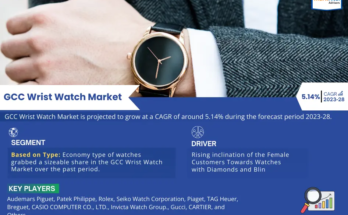Middle East and Africa Smart Wearables Market Overview
The Middle East and Africa Smart Wearables Market is poised for significant growth, with an estimated CAGR of 12.1% during the forecast period from 2024 to 2030. The market size is projected to expand from USD 4.36 billion in 2023 to USD 9.70 billion by 2030. This growth is primarily driven by increasing consumer demand for innovative and aesthetically appealing technological products that can efficiently meet modern lifestyles, particularly among the region’s youthful and tech-savvy population.
Market Dynamics
- Demographic Trends: The region’s burgeoning millennial population, which is keen on tracking fitness and health metrics, is a significant driver for the adoption of smart wearables. This demographic shift, coupled with rising urbanization rates, is leading to higher consumption of these devices.
- Health Monitoring Needs: The ageing population in the Middle East and Africa is influencing the demand for smart wearables aimed at health monitoring. As life expectancy increases, the prevalence of chronic diseases necessitates frequent health tracking, enhancing the appeal of wearable technology in personal care.
- Impact of COVID-19: The pandemic affected various industries, including electronics. Initial declines in demand for smart wearables were observed, yet sales surged in the latter half of 2020 as consumer interest shifted towards health-focused devices, such as fitness trackers and smartwatches.
- Technological Advancements: Innovations in display technologies, such as the shift from traditional LCDs to AMOLED screens, are improving the user experience of smart wearables. These advancements provide benefits such as enhanced battery life and superior display quality, further incentivizing consumer adoption.
- Market Penetration: While smart wearable usage is currently low in regions like South Africa, increasing availability and affordability of devices are expected to foster growth. As technology matures, wearables are likely to transition from personal gadgets to essential enterprise tools.
Market Segmentation
By Product
- Wrist-wear: This segment holds the highest market share, driven by the popularity of smartwatches and fitness bands.
- Neck-wear
- Foot-wear
- Body-wear
- Eye-wear
- Head-wear
- Others
By Application
- Consumer Electronics: Expected to dominate the market, with a surge in demand for smartwatches and fitness trackers becoming commonplace in daily life.
- Healthcare
- Enterprise and Industrial Applications
- Others
By Country
- UAE
- Iran
- Saudi Arabia
- Rest of Middle East and Africa
Regional Insights
In the Gulf Cooperation Council (GCC) region, about 45% of citizens recognize wearable technologies as effective health monitoring tools. The UAE stands out as a market leader due to increasing consumer expenditure, rising internet penetration, and a growing inclination towards stylish and functional wearables.
As of January 2021, the UAE had approximately 9.85 million internet users, which is expected to boost the adoption of smart wearables as connectivity increases. Furthermore, rapid urbanization and the proliferation of retail spaces are reshaping purchasing behaviors, paving the way for smart wearables to blend seamlessly into consumer lifestyles.
Key Players
- Apple Inc. (U.S.): A leader in smartwatches with advanced health tracking features.
- Fitbit Inc. (U.S.): Known for fitness-oriented wearables.
- Garmin Ltd. (U.S.): Focuses on fitness and outdoor activity tracking devices.
- Google LLC (U.S.): Expanding its footprint in the wearable market.
- Fossil Group Inc. (U.S.): Traditional watchmaker adapting to smart wearables.
- Honor (UAE): Local brand gaining traction with competitive pricing and features.
This overview encapsulates the evolving landscape of the Middle East and Africa Smart Wearables Market, highlighting significant growth opportunities, technological innovations, and demographic trends that are shaping the industry.
Key Offerings:
- Past Market Size and Competitive Landscape (2018 to 2022)
- Past Pricing and price curve by region (2018 to 2022)
- Market Size, Share, Size & Forecast by Different Segment | 2024−2030
- Market Dynamics – Growth Drivers, Restraints, Opportunities, and Key Trends by Region
- Market Segmentation – A detailed analysis by segment with their sub-segments and Region
- Competitive Landscape – Profiles of selected key players by region from a strategic perspective
- Competitive landscape – Market Leaders, Market Followers, Regional player
- Competitive benchmarking of key players by region
- PESTLE Analysis
- PORTER’s analysis
- Value chain and supply chain analysis
- Legal Aspects of Business by Region
- Lucrative business opportunities with SWOT analysis
- Recommendations
About Stellar Market Research:
Stellar Market Research is a multifaceted market research and consulting company with professionals from several industries. Some of the industries we cover include medical devices, pharmaceutical manufacturers, science and engineering, electronic components, industrial equipment, technology and communication, cars and automobiles, chemical products and substances, general merchandise, beverages, personal care, and automated systems. To mention a few, we provide market-verified industry estimations, technical trend analysis, crucial market research, strategic advice, competition analysis, production and demand analysis, and client impact studies.
Contact Stellar Market Research:
S.no.8, h.no. 4-8 Pl.7/4 Kothrud
Pinnac Memories Fl. No. 3
Kothrud, Pune, Maharashtra, 411029
[email protected]
+91 9607365656
Related Report Published by Stellar Market Research :




